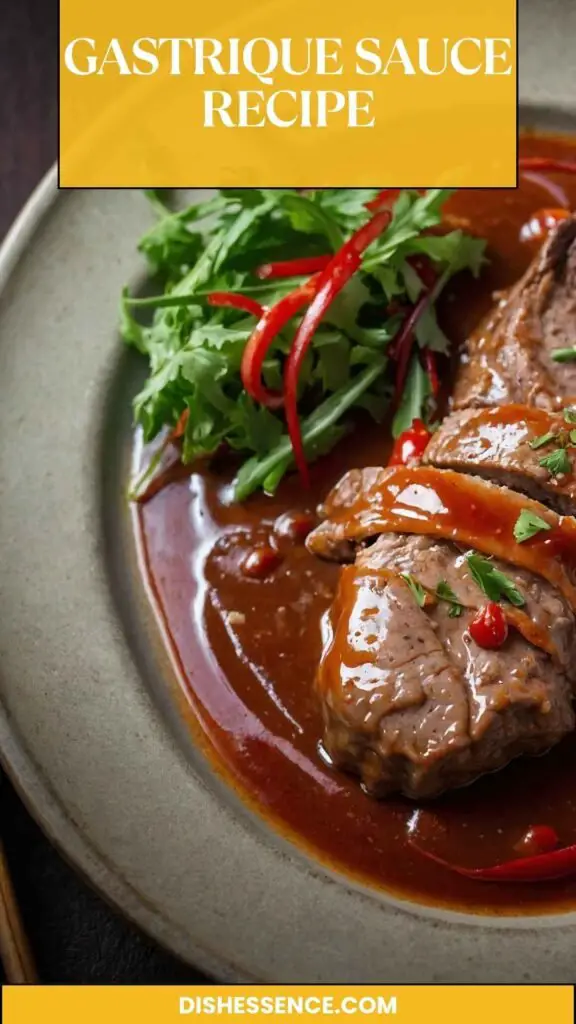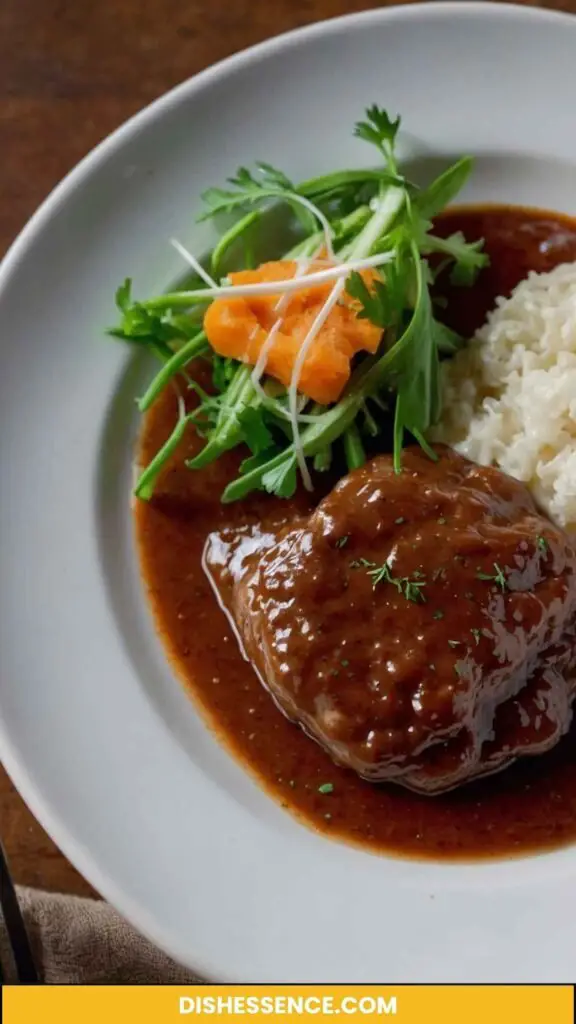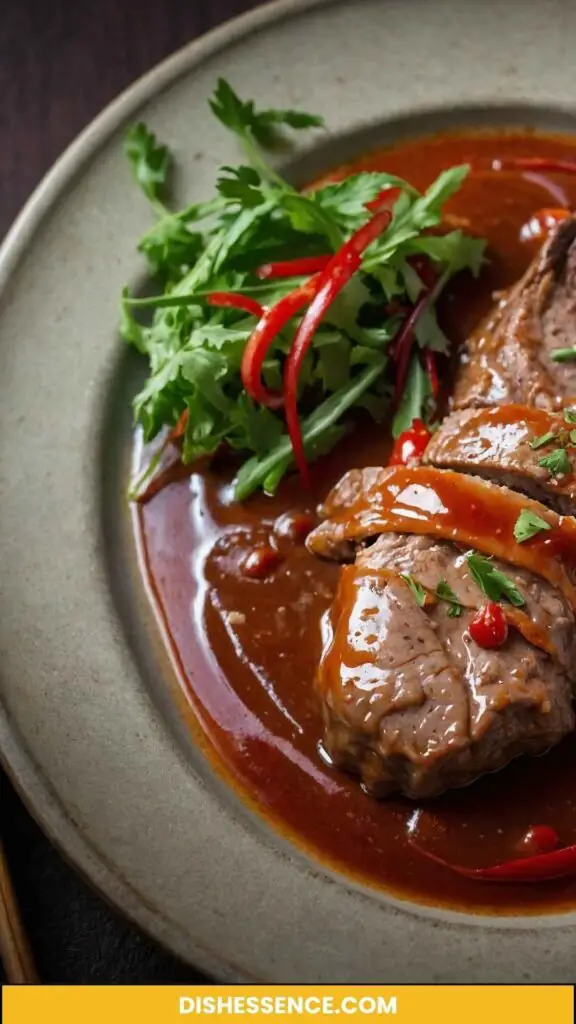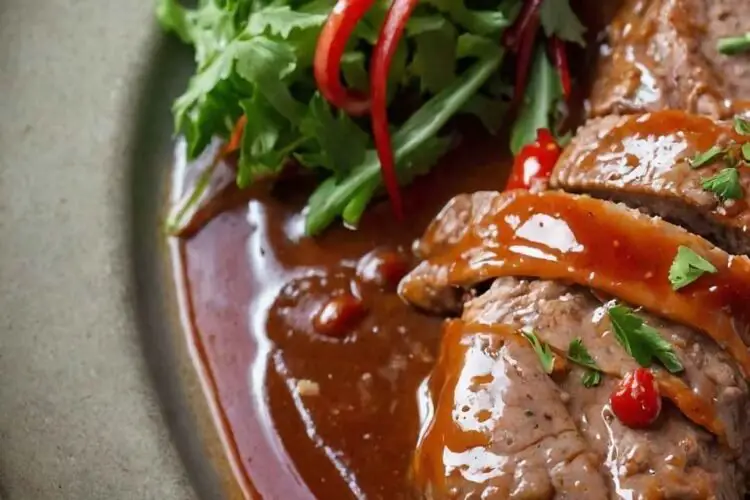A dish dressed to the nines with a sauce that dances uniquely on your palate. Gastrique sauce, a delightful sweet-and-sour concoction, is that secret ingredient that will elevate your cooking. It pairs beautifully with a range of meals.
Think grilled meats, roasted vegetables, or even drizzled over your favorite seafood. You might be wondering how this sauce can add such flair. Trust me; you’re in for a treat.
Let’s dive in, shall we?

You’ll Also Like These Recipes
As a food enthusiast and registered dietitian, I’ve witnessed the myriad ways sauces can transform a dish. Gastrique sauce is no exception.
This versatile sauce is a staple in French cuisine, known for its unique balance of sweetness and acidity. The moment I first tasted it drizzled over duck breast, I was hooked. It opened my eyes to the importance of sauces in elevating food and enhancing flavors.
In this blog post, you will learn everything about gastrique sauce. From its unique flavor profile to how to make it and where to use it. By the end, you will be ready to whip up your own batch and enjoy a sensational dining experience.
What is Gastrique Sauce?
Gastrique sauce is a sauce made from caramelized sugar and vinegar. It’s thick, sweet, and tangy, adding complexity to a variety of dishes. The origins of gastrique date back to classical French cuisine, where it played a pivotal role in balancing flavors.
Typically, a gastrique begins with sugar, which is caramelized, and then vinegar is added to achieve that perfect balance. The magic of this sauce lies in its versatility. You can use it as a base for other sauces or serve it directly over your main dish.
You might be surprised to learn that gastrique has various forms. It can be made with different types of vinegars and flavored with fruits and spices, creating endless possibilities.
How Does It Taste?
Gastrique sauce delivers a flavor experience that is both sweet and tangy. You get the caramelized depth from the sugar and an acidic brightness from the vinegar. Each bite offers a complex combination that invigorates your senses.
It’s the type of sauce that can awaken even the dullest of dishes. Picture this: grilled chicken kissed with a peach gastrique, or a rich pork tenderloin paired with a berry-infused version. The flavor profiles can be adapted to complement the main ingredient beautifully.
Why You’ll Love This Sauce
There are countless reasons to fall for gastrique:
Versatility: You can use it with red meats, fish, or vegetables. The possibilities are endless.
Layered Flavors: It adds a complexity that can elevate even the most basic of dishes.
Homemade Greatness: Making it from scratch allows you to tailor it to your taste preferences. Want it sweeter? Add more sugar. Prefer a sharper taste? Up the vinegar!
Easy to Prepare: You don’t have to be a Michelin-star chef to make gastrique. A short list of ingredients gets you there, and the cooking process is simple.
Now, let’s get on to what you’ll need to create this spectacular sauce.
Ingredients
Here’s what you’ll need:
2 tablespoons unsalted butter
2 cups fresh fruit, such as whole berries or peeled and diced larger fruit (1/2-inch pieces)
1 medium shallot, finely chopped
3 tablespoons fine granulated sugar
2 tablespoons aged balsamic vinegar
1 teaspoon grated fresh ginger
3 tablespoons dry white wine or cognac
1 tablespoon fresh lemon juice
The combination of ingredients opens up all kinds of flavor avenues. Adjust them to your liking, and don’t shy away from experimentation.

Step-by-Step Directions
Step 1: Prepare Your Ingredients
First off, get everything prepped. Wash and prepare your fruits, chop the shallot, and measure out your sugar and vinegars. Having everything ready makes the cooking process much smoother.
Step 2: Caramelize the Sugar
In a medium saucepan, over medium heat, add the sugar. Let it cook undisturbed until it dissolves and turns a light golden brown. Keep an eye on it! You don’t want burnt sugar; we’re after a sweet and smooth flavor.
Step 3: Add the Shallots
Once the sugar has reached that lovely caramel color, toss in the chopped shallots. Stir continuously for about a minute or two until they begin to soften. This step introduces an aromatic layer to your gastrique.
Step 4: Introduce the Vinegar
Time to add the aged balsamic vinegar. The sweet notes of the vinegar will marry perfectly with the caramel. Be careful; it may bubble and steam! Stir well to combine, and let it cook for another minute.
Step 5: Add the Rest Ingredients
Next, pour in the white wine (or cognac) and the lemon juice. Then, sprinkle in the grated fresh ginger. Cook for another 3-5 minutes until the sauce has thickened to your desired consistency. You should see a glaze forming — that’s the magic!
Step 6: Cool and Store
Remove from heat and let the gastrique cool. Once it reaches room temperature, transfer it to a jar or container. Store it in the refrigerator, where it will thicken further.
Tips On Making Gastrique Sauce
Here are some tips to ensure your gastrique shines:
Flavor Infusion: Feel free to infuse your gastrique with other flavors like herbs or spices. Think basil or even chili flakes for heat.
Adjusting Sweetness: If you prefer things a bit tart, add more vinegar. For a sweeter sauce, increase the sugar a notch.
Consistency Checks: The sauce thickens as it cools, so don’t be alarmed if it seems thin while cooking.
Serving Suggestions: Experiment serving it drizzled over grilled meats, roasted vegetables, or even as a dip.
Keep It Clean: Always use fresh fruits and high-quality ingredients for the best taste.
Nutrition Information
Gastrique Sauce Recipe Nutrition Facts
How Do You Store This Gastrique Sauce?
Storing your gastrique is simple. Allow it to cool completely, then transfer it into an airtight container or a glass jar. It will keep well in the refrigerator for up to two weeks. Just give it a quick stir or shake before using, as it may settle.
If you want to keep it longer, consider freezing it in small portions. Ice cube trays work well for this. You can simply pop out a cube when you need it!

What Other Substitutes Can You Use in Gastrique Sauce?
If you find yourself short of an ingredient, don’t fret. Here are some fantastic substitutes:
Honey: Use it as a natural sweetener instead of sugar. It adds a delightful, floral note.
Fruit Juices: Orange or apple juice can replace part of the vinegar for a fruity twist.
Red Wine Vinegar: If balsamic isn’t on hand, try red wine vinegar. It’s slightly sharper but delicious nonetheless.
Maple Syrup: This can add a unique depth to your gastrique. The maple flavor complements savory dishes beautifully.
Cider Vinegar: An excellent alternative with a fruity undertone. It’s less pungent than balsamic, making for a lighter gastrique.

Gastrique Sauce Recipe
Equipment
- saucepan
Ingredients
- 2 tablespoons unsalted butter
- 2 cups fresh fruit such as whole berries or peeled and diced larger fruit (1/2-inch pieces)
- 1 medium shallot finely chopped
- 3 tablespoons fine granulated sugar
- 2 tablespoons aged balsamic vinegar
- 1 teaspoon grated fresh ginger
- 3 tablespoons dry white wine or cognac
- 1 tablespoon fresh lemon juice
Instructions
Step 1: Prepare Your Ingredients
- First off, get everything prepped. Wash and prepare your fruits, chop the shallot, and measure out your sugar and vinegars. Having everything ready makes the cooking process much smoother.
Step 2: Caramelize the Sugar
- In a medium saucepan, over medium heat, add the sugar. Let it cook undisturbed until it dissolves and turns a light golden brown. Keep an eye on it! You don’t want burnt sugar; we’re after a sweet and smooth flavor.
Step 3: Add the Shallots
- Once the sugar has reached that lovely caramel color, toss in the chopped shallots. Stir continuously for about a minute or two until they begin to soften. This step introduces an aromatic layer to your gastrique.
Step 4: Introduce the Vinegar
- Time to add the aged balsamic vinegar. The sweet notes of the vinegar will marry perfectly with the caramel. Be careful; it may bubble and steam! Stir well to combine, and let it cook for another minute.
Step 5: Add the Rest Ingredients
- Next, pour in the white wine (or cognac) and the lemon juice. Then, sprinkle in the grated fresh ginger. Cook for another 3-5 minutes until the sauce has thickened to your desired consistency. You should see a glaze forming — that’s the magic!
Step 6: Cool and Store
- Remove from heat and let the gastrique cool. Once it reaches room temperature, transfer it to a jar or container. Store it in the refrigerator, where it will thicken further.
Notes
Adjusting Sweetness: If you prefer things a bit tart, add more vinegar. For a sweeter sauce, increase the sugar a notch.
Consistency Checks: The sauce thickens as it cools, so don’t be alarmed if it seems thin while cooking.
Serving Suggestions: Experiment serving it drizzled over grilled meats, roasted vegetables, or even as a dip.
Keep It Clean: Always use fresh fruits and high-quality ingredients for the best taste.
Nutrition
Frequently Asked Questions
1. Can I use frozen fruits in gastrique sauce?
Absolutely! Frozen fruits work just as well in a gastrique. Thaw them first to release some juices, which will enhance the flavor.
2. How long can I store gastrique sauce?
When refrigerated, gastrique can last up to two weeks. For extended shelf life, consider freezing portions for use later.
3. Can I make gastrique sauce without fruit?
Yes! You can make gastrique purely with vinegar and sugar. However, the fruit adds complexity and richness that plain gastrique may lack
4. Is gastrique sauce gluten-free?
Most traditional gastriques are gluten-free, but always check the labels on any products you use to ensure they meet your dietary requirements.
5. Can gastrique sauce be served cold?
Yes! Gastrique can be served warm or cold. It can enhance the taste of various dishes regardless of temperature.
6. What dishes pair best with gastrique sauce?
Gastrique works wonders with roasted or grilled proteins like duck, chicken, and pork. It also complements vegetable dishes like a roasted beet salad or grilled asparagus.
Conclusion
Incorporating gastrique sauce into your culinary repertoire is like discovering a hidden gem in your pantry. Its sweet-tangy flavor profile can elevate any dish, making ordinary meals extraordinary.
Whether you’re cooking for a fancy dinner party or a casual weeknight meal, the addition of gastrique is sure to impress. With the tips and recipes shared here, I hope you feel inspired to create your own sauce and experiment in the kitchen.
Next time you find yourself pondering what to add to that grilled chicken or roasted veggies, remember gastrique. Embrace the flavor, relish the creativity, and enjoy the delicious outcomes. Happy cooking!


